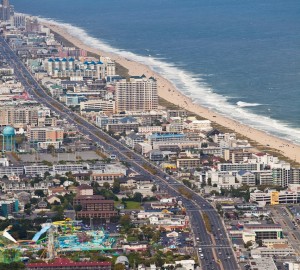
OCEAN CITY – Ongoing efforts are being made to increase safety on Coastal Highway as a reduction in speed limit has been approved along with a plan to reduce traffic lanes in some areas and add a designated bike lane with wider sidewalks in the future.
During a meeting between the State Highway Administration (SHA), Ocean City Police Department (OCPD) and other partners this week, several announcements were made regarding changes to Coastal Highway to improve safety.
Dallas Baker, SHA transportation engineer, announced as of a result of a speed study conducted in Ocean City this summer between 33rd and 62nd streets where 85 percent of drivers traveled 37 mph or less and 50 percent of drivers traveled 33 mph or less the Office of Traffic and Safety and the Chief Engineer approved the request to lower the speed limit from 33rd to 62nd streets from 40 mph to 35 mph.
The Ocean City Mayor and City Council had initiated the study and favored reducing the speed limit in that specific area. Once the change is made, Coastal Highway from Route 90 south will be 35 mph and Route 90 and north to the Delaware line will remain 40 mph. The date of the change will be announced, but will most likely happen during this fall season.
According to Assistant District Engineer Ken Cimino, this summer a pedestrian safety study was completed from 52nd to 59th streets where a majority of accidents occurred on Coastal Highway last year. In this area, SHA increased signage, marked curbs and sidewalks and installed brick patterned walkways to heighten pedestrian awareness.
As a result of the study, SHA will be installing a pedestrian crossing signal on 54th Street where there is currently not a traffic signal. There are currently no traffic signals from 52nd to 56th streets, which is the longest stretch of roadway on Coastal Highway without a light.
The 54th Street pedestrian crossing signal is currently being designed, and once SHA acquires a right-away at that intersection installation will take place during the off-season to be completed by Memorial Day.
According to OCPD data, pedestrian collisions were reduced in the area from 40th to 62nd streets this year. There were five accidents this year compared to 12 last year. South of 40th Street there were 14 pedestrian collisions this year compared to 23 last year, and north of 62nd St. the number of pedestrian collisions were the same as last year with 6 accidents.
The SHA’s next area of study will be 18th to 34th streets where additional curb and sidewalk marking have been completed and an increase in signage, as well as possibly adding brick patterned crosswalks will occur in the near future.
A concept in the works has been titled a “road diet” originating from a traffic-engineering study done by Wallace Montgomery for the State of Maryland last summer.
Cimino explained currently Coastal Highway is eight lanes wide with three mixed-use lanes and a bus lane on each side. The road diet concept runs from 59th Street to Convention Center Drive, and it will no longer have three-mixed use lanes and a bus/bike lane. It is proposed to change to three lanes with the third lane being mixed-use for buses and cars and the extra width of the existing bus lane utilized to become a six-foot wide bike lane and widen sidewalks to seven to 10 feet.
SHAs Office of Highway Design is taking the concept and modeling it under existing traffic conditions to justify the number of traffic lanes being decreased in that portion of Coastal Highway without adversely impacting traffic and causing additional backups.
“They are going to model that using 2020 volumes to see what it will look like from six years now. Then we will look at the models and see what its effects are on the roadway and determine whether or not we want to move this concept forward. Obviously, if its effect is gridlock we will not move it forward,” Cimino said.
Part of the road diet concept is installing a median barrier to deter pedestrians from crossing the highway mid-block and to use marked crosswalks instead. The installation of an ornamental fence has been proposed.
“I am really excited about it and real hopeful that we can get this done,” Cimino said. “We are hoping to see what it would look like in 2020 within the next week or so. Our mind set here on the district level is the road diet is a great idea with the wider sidewalks and a dedicated bike lane but it really needs to have the median fence barrier, some type of discouragement to keep people from crossing.”
OCPD Lt. Scott Harner, who heads the department’s traffic unit, is also anxious to see the outcome of the model.
“Whether you know what the law is or not, if everyone is in a crosswalk it certainly adds a heightened awareness,” he said. “I am very concerned over mid-block crossings, and I think a center median divider at least gets that person to a crosswalk where it’s safer.”
OCPD Captain Kevin Kirstein voiced concern over the median barrier and the road diet being combined into the same project.
“If we are going to wait for funding for the road diet to consider the barrier down the median, I would hope we can separate those a little bit,” he said. “I see the road diet being a multi-million long-term capital project, and then I look at the oriental fence as thousands of dollars to run that fence down there.”
Cimino concluded justification in changes or projects is done through studies and designs before moving forward in requesting funding.
